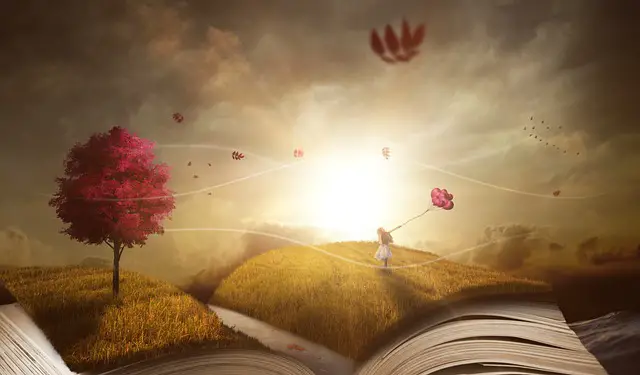Imagination involves creating mental images or concepts that are not necessarily based on real-world experiences, while visualization involves creating mental images of specific objects, people, or scenarios that are based on real-world experiences or memories. Imagination is more about creativity, while visualization is more about recall and reconstruction.
What is the definition of imagination?
(Image by 0fjd125gk87 from Pixabay )

Imagination is the ability to create or visualize something that is not physically present. It is the ability to form new ideas or concepts and to see things in a different way. Visualization is the process of creating mental images or pictures in your mind. It is the ability to see something in your mind’s eye. Both imagination and visualization are important skills for creative thinking.
What is the definition of visualization?
(Photo by Joshua Sortino on Unsplash )

Visualization is the creation of images, diagrams, or animations to communicate a message. The purpose of visualization is to aid understanding, communication, and decision making.
Visualization is one form of communication that can be used to explain data or concepts. It can be used to tell a story, make an argument, or support a claim. When done well, visualization can help people understand complex ideas and make better decisions.
There are many different ways to visualize information. Some common types of visualizations include charts, graphs, maps, infographics, and photos.
Imagination Vs. Visualization – Key differences
Imagination and visualization are related concepts that involve mental processes of creating images in the mind. However, there are some differences between the two:
Imagination: Imagination refers to the ability to create mental images or concepts that do not necessarily correspond to any real-world object or experience. It involves the use of one’s creativity to come up with new ideas, concepts, or scenarios. For example, imagining a unicorn or a world without gravity would be an exercise of imagination.
Visualization: Visualization, on the other hand, involves creating mental images of specific objects, people, or scenarios that are based on real-world experiences or memories. Visualization typically involves the recall of visual information and the ability to recreate it in the mind’s eye. For example, visualizing a specific person’s face, a place one has visited, or a recipe one has cooked before would involve visualization.
In summary, imagination involves the creation of mental images that may not correspond to reality, while visualization involves the recreation of mental images based on real-world experiences or memories.
How to improve your imagination
There are several ways to improve your imagination:
- Engage in creative activities: Activities like painting, writing, or playing music can help improve your imagination by stimulating your creativity and encouraging you to think outside the box.
- Read fiction: Reading fiction can expose you to new worlds and characters, and can help you develop a more vivid imagination by allowing you to visualize the stories in your mind.
- Engage in pretend play: Pretend play, such as playing make-believe or role-playing games, can help improve your imagination by encouraging you to create new scenarios and explore different perspectives.
- Practice mindfulness: Mindfulness meditation can help improve your imagination by helping you to become more aware of your thoughts and feelings, which can lead to new insights and ideas.
- Take on new experiences: Trying new things, such as traveling to a new place or trying a new hobby, can help stimulate your imagination by exposing you to new sights, sounds, and experiences.
Improving your imagination requires an open and curious mindset, a willingness to try new things, and a commitment to regular practice.
How to improve your visualization skills
There are several ways to improve your visualization skills:
- Practice visualization exercises: There are many visualization exercises you can do to improve your visualization skills. For example, you can try to visualize a specific object or person in great detail, or visualize yourself achieving a specific goal.
- Use visual aids: Using visual aids, such as diagrams, mind maps, or pictures, can help improve your visualization skills by giving you a concrete image to focus on.
- Pay attention to details: Paying close attention to details in your surroundings can help improve your visualization skills by training your brain to notice visual information more effectively.
- Engage in memory exercises: Memory exercises, such as memorizing a poem or a sequence of numbers, can help improve your visualization skills by strengthening your ability to create and recall mental images.
- Practice relaxation techniques: Relaxation techniques, such as deep breathing or progressive muscle relaxation, can help improve your visualization skills by reducing stress and increasing your ability to focus.
Improving your visualization skills requires regular practice, attention to detail, and a willingness to experiment with different techniques and exercises. With practice, you can develop a strong ability to visualize and recall visual information more effectively.
What is the difference between vision and visualization?
The main difference between vision and visualization is that vision is the ability to see things in your mind’s eye while visualization is the process of creating mental images to achieve a goal. Both imagination and visualization are important for success.
Visualization is the process of mentally rehearsing a situation in order to achieve a desired outcome. When you visualize, you create a mental image of what you want to happen. This image can be as detailed or as general as you like. The important thing is that you focus on the end result, not on the steps required to get there.
For example, if you want to win a race, don’t visualize yourself crossing the finish line first. Instead, visualize yourself running effortlessly and powerfully, with every stride taking you closer to your goal.
Both vision and visualization are important for success. Vision is the ability to see what could be, while visualization is the process of making it happen.
Does visualization help with imagination?
Yes, visualization can help with imagination. Visualization is a mental process that involves recreating visual information in the mind, which can help improve one’s ability to imagine and create mental images. By practicing visualization exercises, such as visualizing a specific object or scenario, you can train your brain to create more detailed and vivid mental images. This can lead to an improved ability to imagine and create new ideas, concepts, and scenarios. Additionally, visualization can also help to reduce stress and increase focus, which can further enhance your ability to engage in imaginative thinking.
How does visualization affect the brain?
Visualization can have several effects on the brain:
- Activates similar brain regions as real-life experiences: Research has shown that visualization can activate similar brain regions as real-life experiences, suggesting that the brain processes imagined and real experiences in a similar way.
- Enhances neural connections: Visualization can enhance neural connections in the brain, particularly in regions associated with visual processing and memory. This can lead to improved recall and mental imagery skills.
- Reduces stress and anxiety: Visualization can activate the parasympathetic nervous system, which can reduce stress and anxiety. It can also increase levels of dopamine, a neurotransmitter associated with pleasure and reward.
- Improves performance: Visualization can improve performance in various activities, such as sports, music, or academic tasks, by enhancing mental preparation, confidence, and focus.
- Can shape beliefs and attitudes: Visualization can also shape beliefs and attitudes, as it can help individuals form mental images of their goals, aspirations, or desired outcomes, and thus influence their behavior and motivation.
Visualization can have a profound impact on the brain, affecting various cognitive, emotional, and behavioral processes.
Featured Image By – J. Balla Photography on Unsplash








